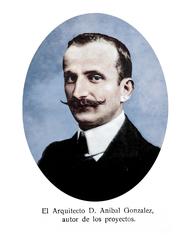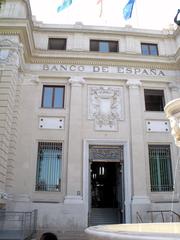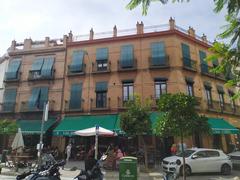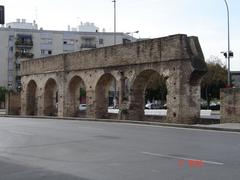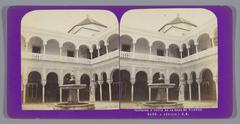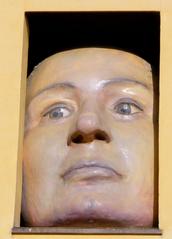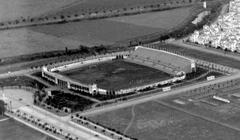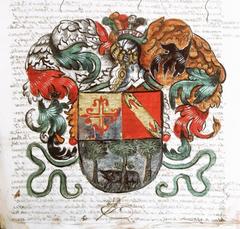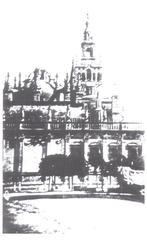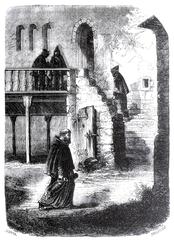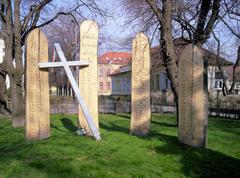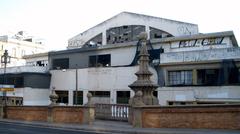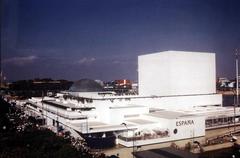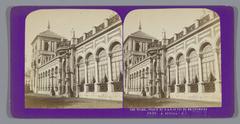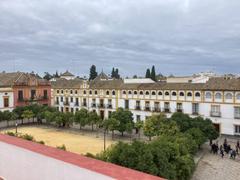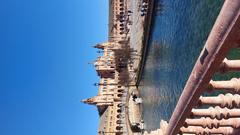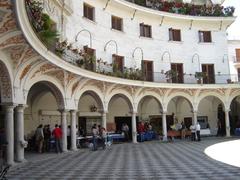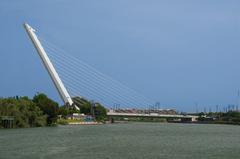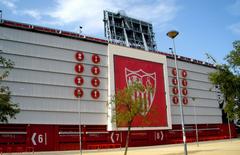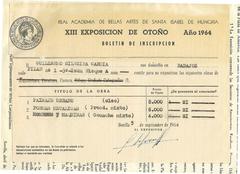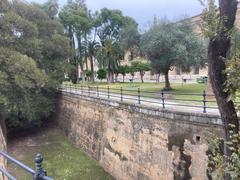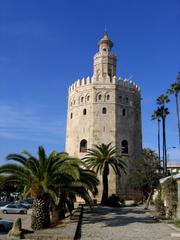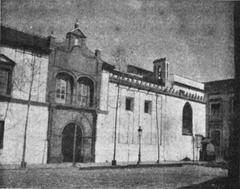
Comprehensive Guide to Visiting Seville, Seville Province, Spain
Date: 14/08/2024
Captivating Introduction
Seville, the enchanting capital of Andalusia in southern Spain, is a city where history and magic intertwine at every corner. Imagine walking down cobblestone streets that have witnessed millennia of conquests, cultures, and celebrations, each whispering stories of a bygone era. The sun-kissed Guadalquivir River that meanders through the city has seen the rise and fall of empires, from the Tartessians and Phoenicians to the Romans and Moors, each leaving an indelible mark (Visit Andalucia).
Seville’s past is as vibrant as its present. Picture the grandeur of Hispalis under Roman rule or the cultural blossoming of Ishbiliyah during the Muslim era. This city’s Golden Age in the 16th century saw it become the jewel of the Spanish Empire, a bustling hub of trade and innovation (Culture Trip). Even through periods of decline, Seville’s resilient spirit saw it rise like a phoenix, culminating in a modern city that beautifully marries its rich heritage with contemporary flair (Britannica).
But Seville is more than its historical landmarks and grand architecture. It’s a sensory symphony where the strum of a flamenco guitar, the aroma of freshly cooked churros, and the sight of the stunning Plaza de España come together to create an unforgettable experience. Dive into the city’s vibrant flamenco culture, lose yourself in the labyrinthine streets of Barrio Santa Cruz, or simply savor the local tapas while soaking in the Andalusian sun (Lonely Planet).
Seville is a city that invites you to explore its secrets and stories, promising a journey that is as enriching as it is magical.
Table of Contents
- Historical Overview of Seville: A Journey Through Time
- Welcome to Seville: Where History and Magic Meet
- Ancient Beginnings: From Tartessians to Phoenicians
- Roman Era: Hispalis and the Emperors
- Visigothic and Muslim Rule: A Melting Pot of Cultures
- Christian Reconquest: A New Dawn
- Golden Age: The Jewel of the Spanish Empire
- Decline and Revival: Rise, Fall, and Rise Again
- Modern Era: A City Reborn
- Hidden Gems and Local Secrets
- Seville’s Sensory Symphony
- Interactive Adventures: Your Seville Quest
- Cultural Etiquette: When in Seville…
- Discover the Magic of Seville: Top Attractions and Hidden Gems
- Discover the Soul of Seville
- Flamenco: The Heartbeat of Seville
- Semana Santa: A Week of Reverence
- Feria de Abril: A Celebration of Andalusian Spirit
- Architectural Marvels: A Blend of Cultures
- Bullfighting: Tradition and Controversy
- Culinary Delights: A Gastronomic Journey
- Festivals: A Year-Round Celebration
- Neighborhoods: A Tapestry of Experiences
- Artistic Expression: A City of Creativity
Historical Overview of Seville: A Journey Through Time
Welcome to Seville: Where History and Magic Meet
Picture this: the sun setting over the Guadalquivir River, casting a golden glow on the ancient city of Seville. This enchanting city, brimming with history and culture, has tales to tell that date back to the 9th century BC. Let’s embark on an adventure through Seville’s fascinating past, quirky secrets, and vibrant present, guided by the whispers of its cobblestone streets and the laughter of its lively locals.
Ancient Beginnings: From Tartessians to Phoenicians
Did you know Seville started as a significant trading hub called Hisbaal by the Phoenicians? Founded by the Tartessians, this city has always been a magnet for traders and explorers, thanks to its strategic spot on the River Guadalquivir (Visit Andalucia). Imagine ancient ships docking, laden with treasures and tales from distant lands – the river was Seville’s lifeline, and it’s where our story begins.
Roman Era: Hispalis and the Emperors
Fast forward to the Roman conquest, and Seville, known as Hispalis, is thriving. Nearby Itálica, founded around 206-205 BC, wasn’t just any colony – it was the birthplace of emperors Trajan and Hadrian (Wikipedia). Wander through the ruins of Itálica today, and you can almost hear the echoes of gladiators and the hustle of Roman life just 9 km from modern Seville.
Visigothic and Muslim Rule: A Melting Pot of Cultures
After the fall of Rome, Seville had a stint under the Visigoths before the transformative Muslim conquest in 711 AD. Renamed Ishbiliyah, the city blossomed into a cultural and commercial beacon. The Almohads, with their grand architectural ambitions, gave us the Giralda – a minaret-turned-bell-tower that’s a must-see (Britannica). Picture the intricate mosaics, the bustling souks, and the scent of spices wafting through the air.
Christian Reconquest: A New Dawn
In 1248, King Ferdinand III of Castile reclaimed Seville, ushering in a new era. While the expulsion of Muslim and Jewish communities left a temporary economic void, the city soon bounced back (Visit Andalucia). Especially after 1492, when Columbus discovered the Americas, Seville became the gateway to the New World, brimming with riches and stories.
Golden Age: The Jewel of the Spanish Empire
The 16th century was Seville’s Golden Age. Picture this: ships setting sail to the Americas, the Casa de Contratación regulating bustling trade, and the city becoming Spain’s commercial capital (Culture Trip). By the late 16th century, Seville was a melting pot of cultures with over 100,000 residents, buzzing with energy and innovation.
Decline and Revival: Rise, Fall, and Rise Again
Every great tale has its lows. Seville’s decline in the 17th century, marked by a devastating plague and economic shifts, was tough (Culture Trip). But the 18th and 19th centuries saw a resilient revival, despite invasions and civil strife (Britannica). Like a phoenix, Seville always finds a way to rise.
Modern Era: A City Reborn
The 20th century transformed Seville into a bustling modern city. With events like the Ibero-American Exposition of 1929 and Expo ‘92, Seville showcased its rich heritage and contemporary flair (Wikipedia). As the capital of Andalusia, it continues to be a vibrant cultural hub.
Hidden Gems and Local Secrets
Beyond the tourist hotspots, Seville is full of surprises. Ever heard of the Flamenco flash mobs that spontaneously erupt in the streets? Or the tiny bars where locals share tapas and tales? Dive into the lesser-known side of Seville – visit the quirky Casa de Pilatos or the serene gardens of Murillo. These hidden gems are the soul of the city.
Seville’s Sensory Symphony
Seville is a feast for the senses. Hear the strum of a guitar and the passionate cry of a flamenco singer. Smell the orange blossoms in spring and the aroma of freshly cooked churros. Taste traditional tapas like jamón ibérico and sip on a glass of sherry. Feel the warm sun on your skin as you stroll through the Plaza de España. See the stunning blend of Gothic, Mudéjar, and Renaissance architecture that tells the city’s story.
Interactive Adventures: Your Seville Quest
Ready for a challenge? Try a Flamenco dance lesson or a tapas tasting tour. Hunt for the best viewpoints of the Giralda or embark on a photo scavenger hunt through the winding streets of the Barrio Santa Cruz. Engage with Seville actively – it’s the best way to experience its magic.
Cultural Etiquette: When in Seville…
Navigating Seville’s social nuances is part of the charm. Greet locals with a friendly “Hola” and remember that dining times are later—lunch (2-4 pm) and dinner (9 pm). Embrace the local pace and customs for a truly immersive experience.
Discover the Magic of Seville: Top Attractions and Hidden Gems
Catedral de Sevilla
Did you know the Catedral de Sevilla is the largest Gothic cathedral in the world? This UNESCO World Heritage site was built between 1402 and 1506 on the ruins of a former mosque. Climb La Giralda bell tower for breathtaking views of the city and pay respects at Christopher Columbus’ tomb. Tickets are €11 online, €12 in person, plus €5 for an audio guide (Nomadic Matt).
Real Alcázar
Step into a fairytale at the Real Alcázar, a royal palace with roots as a Moorish fort. This dazzling UNESCO site showcases exquisite Mudéjar architecture, vibrant gardens, and mesmerizing tile work. General admission is €14.50, and it’s free on Monday afternoons (Nomadic Matt).
Plaza de España
Imagine a grand semi-circular plaza adorned with colorful mosaics representing Spain’s provinces. Built for the 1929 Ibero-American Exposition, the Plaza de España is a stunning blend of Spanish, Moorish, and Art Deco styles. Catch a live flamenco performance or rent a boat for a leisurely ride on the canal (The Tour Guy).
Barrio de Santa Cruz
Get lost in the medieval charm of Barrio de Santa Cruz, Seville’s former Jewish quarter. Wander through narrow alleyways and serene courtyards, and soak in the vibrant atmosphere. This picturesque neighborhood is perfect for a leisurely afternoon stroll (PlanetWare).
Parque de María Luisa
Looking for a serene escape? Parque de María Luisa, next to Plaza de España, offers lush gardens, fountains, and shaded paths. It’s the perfect spot for a relaxing afternoon surrounded by nature (PlanetWare).
Metropol Parasol
Known as “Las Setas” (The Mushrooms), the Metropol Parasol is a modern wonder designed by architect Jürgen Mayer. This massive wooden structure houses an archaeological museum and offers panoramic city views from its observation deck (Lonely Planet).
Casa de Pilatos
Experience a blend of Gothic, Mudéjar, and Renaissance styles at Casa de Pilatos, a 16th-century palace. With its exquisite courtyards, gardens, and Roman sculptures, this palace offers a glimpse into Seville’s aristocratic past (Nomadic Matt).
Archivo de Indias
Dive into Spain’s colonial history at the Archivo de Indias, a UNESCO World Heritage site. This Renaissance building houses extensive documents related to the Spanish Empire in the Americas (Visit Andalucia).
La Maestranza
Explore Spain’s most iconic bullring, La Maestranza. While bullfighting is controversial, guided tours offer insights into the history and traditions of this Spanish sport. Free entry from 5:30 to 7:30 pm on Wednesdays (Lonely Planet).
Isla Mágica
For a day of family fun, head to Isla Mágica theme park. Open from late April, the park features six themed areas, including pirates and the Amazon rainforest. It’s a great mix of fun and education for all ages (The Tour Guy).
Flamenco Shows
Seville is the heart of flamenco. Don’t miss a live performance at one of the many venues across the city. Book tickets in advance to secure your spot (Lonely Planet).
Tapas Culture
Immerse yourself in Seville’s tapas culture. Hop from bar to bar, savoring dishes like jamón ibérico and patatas bravas. It’s a culinary adventure not to be missed (Lonely Planet).
Semana Santa and Feria de Abril
Experience Seville’s vibrant traditions during Semana Santa and Feria de Abril. Witness elaborate processions and religious ceremonies during Holy Week, then join the April Fair’s flamenco dancing, horse parades, and festive atmosphere (Nomadic Matt).
Guadalquivir River
The Guadalquivir River is Seville’s lifeblood. Enjoy boat tours or riverside walks to experience the city’s scenic beauty and historical significance (Lonely Planet).
Triana Neighborhood
Cross the Guadalquivir to Triana, a neighborhood rich in ceramics, flamenco, and lively markets. It’s a must-visit for a taste of local life and traditions (Lonely Planet).
Visitor Tips
- Best Time to Visit: Spring (March to May) and autumn (September to October) offer comfortable temperatures and major events like Semana Santa and Feria de Abril (Rove.me).
- Stay Hydrated: Seville’s summer heat is intense. Carry water and wear sunscreen (Lonely Planet).
- Book in Advance: Popular attractions like the Real Alcázar book up quickly. Reserve tickets online (Lonely Planet).
- Local Etiquette: Seville’s dining times are later—lunch (2-4 pm) and dinner (9 pm) (Lonely Planet).
By exploring these top attractions and following these practical tips, visitors can ensure a memorable and enriching experience in Seville.
Discover the Soul of Seville
Flamenco: The Heartbeat of Seville
Welcome to Seville, where every street whispers tales of passion and history. Let’s dive into the vibrant rhythm that defines this city: Flamenco. Born right here in Seville, Flamenco is more than just music and dance—it’s an emotional explosion combining cante (singing), toque (guitar playing), baile (dance), and jaleo (vocalizations and rhythmic sounds). Originating in the 18th century, Flamenco is a rich blend of Andalusian, Gypsy, Moorish, and Jewish cultures. Experience the soul-stirring performances at hidden gems like La Casa del Flamenco and Tablao Flamenco El Arenal. Get ready to be captivated by the Sevillian spirit!
Semana Santa: A Week of Reverence
Imagine the streets of Seville draped in the solemnity and reverence of Semana Santa, or Holy Week. This isn’t just a religious festival—it’s a profound, week-long tribute to faith, featuring grand processions led by brotherhoods carrying religious statues, all to the haunting melody of traditional music and the fragrant plumes of incense. It’s a sensory journey that will leave you in awe. Peek behind the scenes and uncover how locals prepare for this massive event (source).
Feria de Abril: A Celebration of Andalusian Spirit
Two weeks post-Easter, Seville bursts into a riot of color and joy with the Feria de Abril. Picture this: fairgrounds teeming with casetas (beautifully decorated tents), locals in flamboyant flamenco dresses, and the infectious energy of spontaneous dance and laughter. This isn’t just a festival; it’s a deep dive into Andalusian culture. Want to blend in? Grab a flamenco dress or suit and join the fiesta (source).
Architectural Marvels: A Blend of Cultures
Seville’s skyline is a canvas of its rich past. Marvel at the Royal Alcázar of Seville, a UNESCO World Heritage Site exemplifying Mudéjar architecture—a stunning fusion of Islamic and Christian artistry. Originally a Moorish fort, it later transformed into a royal palace, flaunting intricate tile work and lush gardens. Then, there’s the Seville Cathedral, the world’s largest Gothic cathedral, home to Christopher Columbus’ tomb. Its Giralda tower, a former minaret, offers breathtaking views of the city.
Bullfighting: Tradition and Controversy
Love it or loathe it, bullfighting is woven into Seville’s cultural fabric. The Plaza de Toros de la Real Maestranza, an iconic bullring, hosts this age-old tradition from March to October. While opinions on bullfighting are divided, its historical and cultural roots in Seville are undeniable. Discover the behind-the-scenes rituals and the passionate debates surrounding this tradition.
Culinary Delights: A Gastronomic Journey
Seville’s culinary scene is a feast for the senses. Imagine savoring tapas like jamón ibérico (Iberian ham), gambas al ajillo (garlic shrimp), and espinacas con garbanzos (spinach with chickpeas) at La Cochera del Abuelo, a cozy spot in an 18th-century carriage house. And don’t miss out on sherry, the local fortified wine. Sip it at an alfresco café as you soak in Seville’s 3,000 annual sunny hours (source). Check out our mini-quest: find the best tapas in town!
Festivals: A Year-Round Celebration
Seville’s calendar is dotted with vibrant festivals. Beyond Semana Santa and Feria de Abril, the city celebrates Corpus Christi with elaborate processions and the Flamenco Biennial Festival, drawing artists globally. The city’s cultural scene spans traditional and contemporary events, from theatre and film to dance seasons (source). Why not join a local theater troupe for a day?
Neighborhoods: A Tapestry of Experiences
Explore Seville’s neighborhoods, each with its unique charm. Wander through Santa Cruz, the old Jewish quarter, with its narrow streets and picturesque plazas. Discover landmarks like the Royal Alcázar, Seville Cathedral, and the Flamenco Museum. In El Arenal, experience history and nightlife along the Guadalquivir River. And don’t miss Triana, the flamenco heartland, known for its ceramic workshops and vibrant bars.
Artistic Expression: A City of Creativity
Seville pulses with artistic energy. It’s the backdrop for over 100 operas, including “Carmen” and “The Barber of Seville.” The city’s museums, like the Museum of Fine Arts, showcase masterpieces of Spanish art, while contemporary galleries highlight emerging talents. Street art, music festivals, and theaters add to Seville’s rich cultural tapestry, making it a city of boundless creativity.
Call to Action
Seville is not just a destination; it’s a journey through time, culture, and sensory delight. From its ancient beginnings as a trading hub to its Golden Age as the heart of the Spanish Empire, Seville’s history is as rich and varied as its present-day attractions (Visit Andalucia). The city’s resilience through periods of decline and its vibrant revival in the modern era showcase its indomitable spirit and enduring allure (Britannica).
As you wander through Seville’s streets, you’ll encounter architectural marvels like the Catedral de Sevilla and the Real Alcázar, both testaments to the city’s historical grandeur (Nomadic Matt). Yet, it’s in the hidden corners and lesser-known spots where Seville truly reveals its soul. Whether it’s the spontaneous flamenco performances, the local tapas bars, or the serene gardens, these hidden gems offer a glimpse into the city’s vibrant life and culture (Lonely Planet).
Seville is a feast for the senses, a city where every experience, from tasting traditional tapas to exploring the historic neighborhoods, becomes a cherished memory. Its festivals, like Semana Santa and Feria de Abril, bring the city’s traditions to life, offering a deeper connection to its cultural roots (Nomadic Matt).
As you prepare to explore this captivating city, let Audiala be your guide. With expertly crafted audio guides that delve into Seville’s history, hidden gems, and local secrets, Audiala offers an enriching and immersive experience. Download Audiala before your visit to unlock the full magic of Seville and make your journey truly unforgettable.
References
- Visit Andalucia. (n.d.). History of Seville. source
- Wikipedia. (n.d.). History of Seville. source
- Britannica. (n.d.). Sevilla, Spain. source
- Culture Trip. (n.d.). A Brief History of Seville’s Golden Age. source
- Nomadic Matt. (n.d.). Seville Travel Guide. source
- Lonely Planet. (n.d.). Top Things to Do in Seville. source


